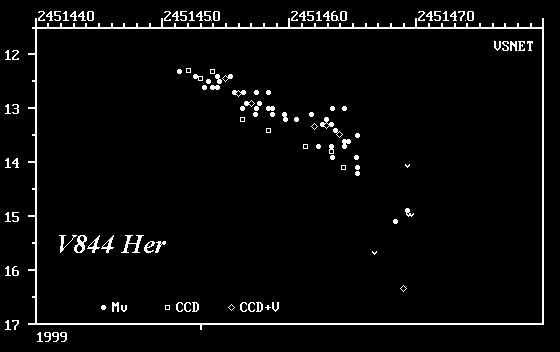
The discovery of V844 Her was announced in IBVS 4360 (August 1996) by Dr. S.V. Antipin (Sternberg Astronomical Institute), as Var 43 in the field of the bright star Eta Herculis. This followed a study of photographic plates of the Eta Her region taken with the 40cm astrograph in the Crimea, resulting in the discovery of some 27 new variable stars in a 10 x 10 degree field centred upon the bright star. Antipin reports that most of the discoveries are RR and EB type stars, with Var 43 proving to be a Dwarf Novae with a best observed outburst period of 12 and 18 days. Var 43 was found to be in outburst on JD 244175.489 (June 1972)1.
The announcement of the discovery was also posted on to VSNET2 by Taichi Kato. Following this, Charles Scovil photographed the field on October 7th, 1996, and found Var 43 Her to be in outburst at magnitude 12.2, fading to 14.3 by October 12th.3 CCD Photometry undertaken by Tonny Vanmunster (CBA Belgium) on October 13/14 resulted in the detection of weak superhumps4, thus classifying Var 43 Her as a new member of the UGSU class of DNe.
Var 43 Her (now re-named V844 Her) was next seen in outburst on May 21st, 1997, by Robert Modic at visual magnitude 13.1. This again proved to be a superoutburst, with a superhump period measured by several CBA observers to be 0.05602±0.00011 days following CCD photometry obtained between May 25-31st5. This proved to be amongst the shortest known periods for any UGSU star, raising the interesting question of which category of ultra short UGSU stars does V844 Her belong to - UGWZ or UG ERUMa? From VSNET reports, T. Kato suggests a supercycle period of some 220-230 days, with the apparent absence of normal outbursts6.
R. Modic once again detected an outburst of V844 Her on December 10th, 1998, at visual magnitude 12.8. This outburst was poorly covered by both visual and CCD observers due to its low position in the western sky during early evening in Winter.
The most recent outburst was detected by Hazel McGee on September 29th, 1999, at visual magnitude 12.3. This outburst once again proved to be a superoutburst, with early stage superhumps being detected by T. Kato and M. Uemura (Ouda station, Japan) on October 1st7. The outburst has been well covered by observers world-wide, with only one day reported without observations during the 20 days duration of the outburst. The light curve here is taken from observations reported to VSNET.

Since the IBVS announcement in August 1996, probably one outburst has been missed during Feb-Mar 1998. If we take the outburst period as being around 260 days (revised from T. Kato's 230 days from outburst dates), then we should expect the next superoutburst to occur in the summer of next year. However continued monitoring of the field in the meantime is to be encouraged, as normal outbursts (if they actually occur) have still to be observed.